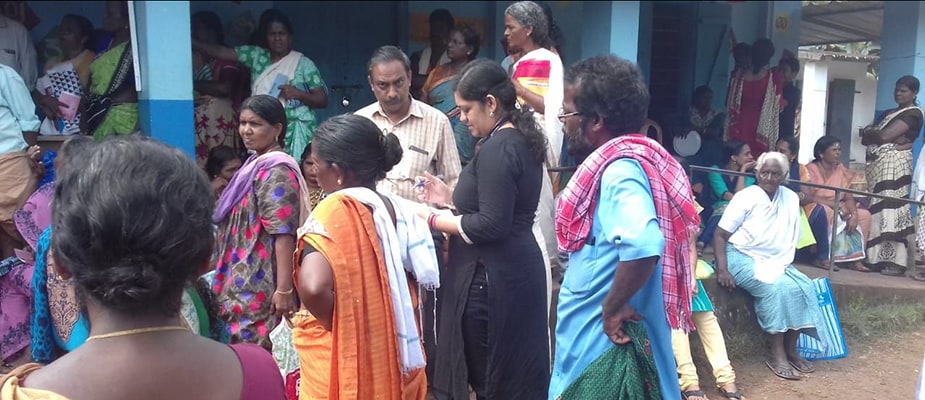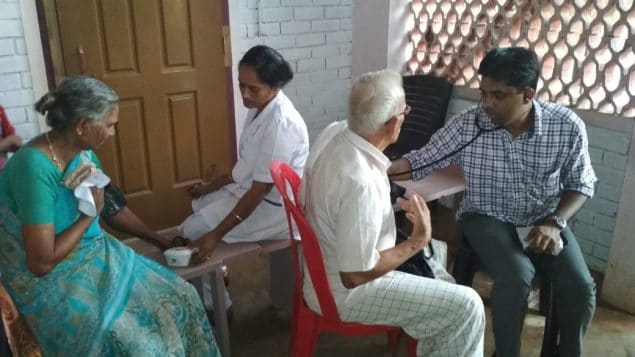How Kerala Avoided a Chronic Disease Crisis

A field epidemiology resident connects with care providers and patients at a flood relief camp in Kumarakom, Kerala. Photo: Renjith Krishna
A river of mud and debris surged through the streets of Kerala in August 2018. The southwestern Indian state was hit with unusually high rainfall during monsoon season, overflowing dams and causing devastating floods and landslides that affected hundreds of villages and destroyed thousands of miles of roads and homes.
Over one million residents were evacuated and many moved to relief camps. For those with chronic conditions like hypertension (high blood pressure) and diabetes, life in a relief camp without access to medication or medical records can be dangerous.
“During an emergency we often consider potential complications from communicable diseases, but untreated chronic conditions can quickly become life-threatening,” explains Dr. Ganeshkumar, a medical scientist with the Indian Council of Medical Research-National Institute of Epidemiology (NIE).
Nearly 1 in 3 people impacted by the flood were estimated to have diagnosed hypertension, but due to emergency conditions, nearly 90% of these flood victims were living with uncontrolled blood pressure. Left untreated, high blood pressure could become a “silent killer” causing heart disease, stroke, or kidney failure with little warning.
Springing into Action
Within days of the floods, Kerala’s state health department teamed up with NIE to develop an action plan to address noncommunicable disease (NCD) risk factors like uncontrolled hypertension in the flood region.
NIE established a multi-step approach to respond to the burgeoning crisis. The team prepared guidelines for the treatment of high-risk NCD conditions based on the latest research and global best practices, increased local NCD medication supplies, and coordinated referral systems for people requiring emergency medical care. They then established reporting protocols throughout the state so they could actively monitor the crisis.
“Streamlining NCD service delivery by integrating into primary care is challenging during emergencies due to the competing priorities and the scattered displacement of patients,” explains Dr. Bipin Gopal, State NCD Nodal Officer in Kerala. “High-level planning is essential to ensure commitment and allotment of resources, but collaboration with stakeholders in the field is absolutely critical for interventions to be successful.”
Ready in an Emergency

Local physicians screen for hypertension at a primary health center in Vanimal village in northern Kerala. Photo: Abishek S.
To help coordinate on-the-ground efforts, NIE deployed field epidemiology residents to the hardest hit districts in Kerala. Field epidemiologists, commonly referred to as disease detectives, are part of the global health workforce trained to guide the response to urgent public health problems by tracking, containing, and eliminating health threats.
Within a week after flooding began, the field epidemiology residents were collaborating with district medical officers and administrators to familiarize physicians in the relief camps and at primary care centers with the emergency treatment and referral guidelines. They provided support to increase public awareness about the danger of untreated NCDs and they trained health centers on the NCD emergency response monitoring system.
Chronic but Urgent
Since the 1980s, CDC has collaborated with countries to train a global workforce of field epidemiologists through the Field Epidemiology Training Program (FETP). FETP residents and graduates have responded to some of the world’s most urgent health events, including the Ebola virus outbreak in West Africa.
In 2018, CDC—in coordination with ministries of health, the World Health Organization, Resolve to Save Lives, and other global partners—launched an effort to strengthen NCD epidemiology within the training program, with a focus on cardiovascular disease and hypertension. Through intensive on-the-job training and mentorship, FETP NCD residents develop skills to quickly identify health risks, monitor health interventions, and use data to inform programs and policies.
Two of the epidemiologists who led the on-the-ground coordination in Kerala are part of the first FETP NCD cohort in India.
A Step Ahead
While Kerala is still recovering from the floods, health professionals in the region have provided over 100,000 NCD consultations. The quick action of NIE and the local field epidemiologist residents likely prevented scores of complications and deaths.
With chronic conditions requiring long-term care and sustained involvement from the health system, advocates of strengthening NCD prevention and control efforts have long asserted that health systems capable of addressing NCDs are more robust and better prepared to respond to all types of health threats.
All residents in India’s first FETP NCD cohort are now focusing on continuing to strengthen local health systems by supporting other districts on integrating hypertension and cardiovascular disease management into primary care.
“Field epidemiology training strengthens the national workforce and health system so that both can be responsive when an emergency occurs,” states Dr. Ganeshkumar. “We’ve seen that in action in Kerala.”
Learn More
- Blog: Confronting the Silent Killer in Nepal
- World Hypertension Day Infographic
- Field Epidemiology Training Program
- The Lancet: Care of non-communicable diseases in emergencies
- World Health Organization: Action plan for prevention and control of noncommunicable diseases in South-East Asia
- HEARTS Technical Package






















.png)











No hay comentarios:
Publicar un comentario